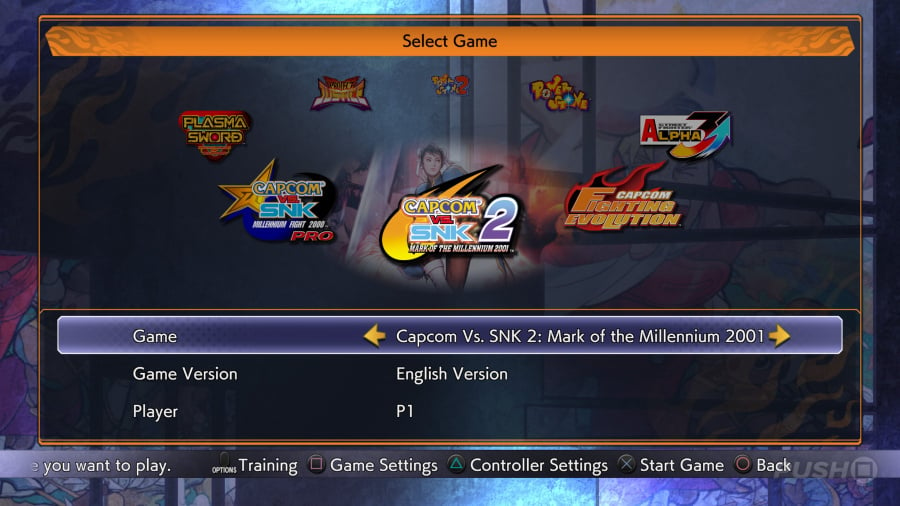
The place its predecessor largely centered on DarkStalkers – together with a few titles which by no means launched exterior of Japan – Capcom Preventing Assortment 2 largely turns its consideration to SEGA’s notorious NAOMI arcade board, so we’re taking a look at a compilation of largely Dreamcast-era brawlers right here.
In the event you’ve performed Capcom Preventing Assortment or Marvel vs. Capcom Preventing Assortment: Arcade Classics, you then’ll be aware of the presentation: you’ll be able to toggle between Japanese and USA ROMs at will, fast save your progress, and discover lots of of gallery gadgets, spanning every part from idea artwork by means of to hand-written design paperwork.
Crucially, all the video games have additionally been enhanced with rollback netcode, though we should always stress within the pre-release overview atmosphere we weren’t capable of correctly put this by means of its paces. It additionally needs to be famous that there’s no crossplay between consoles, which dramatically reduces the potential participant pool you could possibly discover.

However from our expertise, the emulation is rock-solid, with quite a lot of completely different personalisation choices pertaining to simulated scanlines, facet ratios, and so forth. It’s price including that in all circumstances you’re getting the arcade variations of those video games, so any extra house console modes – just like the World Tour within the PS1 model of Road Fighter Alpha 3 – are absent.
Because of the multi-game nature of this launch, and the sheer number of the content material included, we’ve determined to breakdown every recreation individually for this overview.

Whereas it definitely wasn’t the unique Capcom and SNK crossover, we suppose you may argue Capcom vs. SNK: Millennium Combat 2000 is the primary one to essentially matter. Offered right here as a part of its expanded Professional re-release, including Dan Hibiki and Joe Higashi to the roster, this 2001 effort brings the very best of King of Fighters and Road Fighter Alpha below one roof.
Spotlight gameplay methods embrace the Groove mechanic, which alters the best way the Tremendous meter works relying in your private persuasion. It additionally provides a barely unbalanced Ratio system, the place lowly fighters like Sakura take up one spot and extra beastly opponents like Evil Ryu can occupy as much as 4. It means you’ll must assume comparatively fastidiously about the easiest way to compose your workforce.

The sprites are chunky and well-animated, whereas the backgrounds are superbly illustrated and incorporate 3D components to assist convey them right into a extra trendy period. We’re notably keen on the transition animations which set off between these levels; ground-breaking on the time, they’ve a sort of kitsch-like attraction when appreciated from a contemporary perspective.

Among the many greatest ever sprite-based fighters, Capcom vs. SNK 2: Mark of the Millennium 2001 improves on virtually every part from its already likeable predecessor, other than maybe the stage introduction animations.
Switching from a four-button management scheme to a extra acquainted six-button system, this blows out all 48 characters’ arsenals, and incorporates six completely different Groove types to enhance nearly limitless selection. These mechanics are impressed by every part from Road Fighter 2 to Samurai Shodown, and alter extra than simply the Tremendous meter, but additionally the elemental combating mechanics.

Taking full benefit of SEGA’s NAOMI {hardware}, this recreation substitutes the beautiful pixel-based backgrounds from its predecessor to totally rendered 3D levels, much like these in Marvel Vs. Capcom 2: New Age Of Heroes. Personally, we don’t assume they’ve aged wherever close to in addition to the earlier recreation, however there are some undeniably neat Easter eggs and enjoyable distractions.
Our solely actual criticism of this recreation, which was additionally a grievance on the time, is the way it recycles the sprites of some character fashions from historical releases, like Morrigan from DarkStalkers. In comparison with the brand new fashions created bespoke for this launch, there’s an absence of total consistency to the artwork which prevents it from attaining true greatness..

Capcom’s legacy could also be stacked with all-time basic combating video games, however Capcom Preventing Evolution – also referred to as Capcom Preventing Jam – was a uncommon misfire for the writer. It additionally represents a low-point for this compilation, regardless that we expect it’s ballsy of the Japanese writer to incorporate it.
The sport began life as a 3D fighter named Capcom Preventing All-Stars: Code Holder, which was in the end cancelled in 2003. It consists of characters from Road Fighter 2, DarkStalkers, Road Fighter Alpha, Pink Earth, and Road Fighter 3, normally fairly actually recycling the unique property and animations – though in some situations frames have been inexplicably eliminated.

The backdrops are horrific; a dramatic and staggering step backwards from the gorgeous paintings used within the SNK crossover video games. And the fight system doesn’t actually work, with every character tethered to its distinctive sequence’ mechanics, making for an total mess of a aggressive expertise.
New character Ingrid, who’s the one new sprite included right here, is a cool character design – however she’ll eternally be tethered to this failed fighter, which is a horrible disgrace.

In the event you personal the Road Fighter thirtieth Anniversary Assortment, you then’ll have already got a model of Road Fighter Alpha 3. However this Higher re-release, deployed in Japanese arcades again in 2001, incorporates the extra characters from the unique house console releases, together with Dee Jay, Fei Lengthy, T Hawk, Guile, Evil Ryu, and Shin Akuma.
Outdoors of the expanded character roster, the gameplay largely stays unchanged. The principle system right here revolves round “isms”, with three completely different energy gauges paying homage to earlier Road Fighter video games, every with completely different strengths and weaknesses. A few of these include extra strikes related, so there’s loads to discover and experiment with.

Maybe the one draw back right here is that this nonetheless isn’t the full model of the sport, as subsequent handheld ports, together with the miraculous Recreation Boy Advance conversion and arcade-perfect PSP launch, added in much more characters, together with Ingrid from the aforementioned Capcom Preventing Evolution. Because the arcade launch, this model can be lacking the popular World Tour single participant marketing campaign from the PS1 port.

In contrast to anything on this compilation, Energy Stone’s closest analogue is probably Tremendous Smash Bros., however even then its 3D battlegrounds make it wholly distinctive in comparison with Nintendo’s mascot mash-up.
One other title developed for SEGA’s NAOMI arcade board and later ported to the Dreamcast, combatants from throughout the globe duke it out in Nineteenth-century arenas in quest of the legendary Energy Stones. The gameplay sees you accumulating completely different colored gems from across the stage in an effort to open up your fight arsenal, culminating in devastating tremendous assaults.

You can too decide up weapons, starting from swords to machine weapons, making for a chaotic expertise.
Whereas the unique entry is easy compared to its sequel (extra on that shortly), its simplicity does have some benefits, specifically its fight is extra legible and the pacing is extra constant with out the distraction of the boss battles and stage transitions from its extra expansive successor.
It needs to be famous that the sensible VMU minigames from the Dreamcast model are sadly not included in any capability right here.

Larger, higher, extra dangerous ass is the mantra of sequel Energy Stone 2, though personally we’ve all the time most well-liked the comparative simplicity of its predecessor. The sequel ups the variety of gamers on display screen to 4, leading to absolute bedlam. Levels additionally change over time, so chances are you’ll end up combating on a warship earlier than skydiving to the bottom, creating a way of dynamism.
The normal battles of the arcade mode are interspersed with boss fights and minigames, just like the notorious Pharaoh Walker battle, which sees you going through off towards a large Egyptian kaiju. There are additionally far more weapon pick-ups than within the recreation’s predecessor, together with every part from curler blades to bear traps.

The sheer chaos is definitely entertaining, nevertheless it’ll come down to private desire whether or not you like it to the unique recreation’s extra reserved strategy.
One factor we might add is that, as that is the arcade model, the superb Journey Mode from the Dreamcast version is absent, stripping the expertise of a lot of its single participant longevity.

Mission Justice is the second – and final, as issues stand – Rival Faculties recreation, initially launched in 2000 for arcades utilizing SEGA’s Naomi board. The unique recreation ran on Sony’s PlayStation-based ZN-2, so visually it represents an actual improve. The 3D combating stays acquainted, although, though it upgrades its predecessor’s two-player groups to three-player groups, echoing Marvel vs. Capcom 2: New Age of Heroes.
This new team-based format unlocks some contemporary gameplay alternatives, incorporating extra Group-Up assaults and the brand new super-powerful Social gathering Up assault, which contains all three characters directly. Curiously, this may be interrupted by a competitor, triggering a sort of “tag” mechanic, the place the primary participant to get a success in comes out the victor of the minigame.

Whereas this model of the discharge lacks the board recreation marketing campaign from the Japanese version of the Dreamcast port, you’ll be able to nonetheless select between the arcade iteration’s Story Mode and Free Mode, with the latter locking you to the narrative arcs of the particular faculties from the franchise’s lore. These have neat comedian ebook panel cutscenes, that are extraordinarily enjoyable to soak up, even from a up to date perspective.
Particular point out have to be reserved for the creativeness of the character designs in Mission Justice, and the Rival Faculties franchise at giant. Among the many new additions right here is Momo Karuizawa, a tennis participant from Gorin Excessive, and Yurika Kirishima, who fights with a violin.
The dedication to the sequence’ “faculty membership” theme is ingenious, and it units this franchise aside from different fighters, the place you’re typically controlling martial arts specialists et al.

Although it was finally ported to the Dreamcast, Plasma Sword: Nightmare of Bilstein is without doubt one of the few video games on this compilation – together with Capcom Preventing Evolution, after all – which doesn’t run on SEGA’s NAOMI chipset. As an alternative, curiously, it’s powered by Sony’s PlayStation-based ZN-2.
That’s as a result of predecessor Star Gladiator – Episode 1: Closing Campaign was made with the PS1 in thoughts, at a time when 3D fighters like Tekken and Virtua Fighter had been starting to eat Capcom’s lunch.
The sport was poorly acquired in its day, partly attributable to unfavourable comparisons with SoulCalibur, which is comprehensible contemplating Namco’s fighter appeared a number of generations past what Capcom was providing right here.

However whereas it does play considerably equally to the aforementioned weapons-based brawler, it does have some fascinating wrinkles of its personal, specifically a placing Star Wars-inspired anime fashion and methods just like the Plasma Area, which let you expend one degree out of your Energy Gauge in an effort to put opponents in a sort of stasis and deploy character particular buffs, like rising in measurement or stopping time.
Whereas it’s largely unremarkable, we do assume there’s a je ne sais quoi to Plasma Sword’s archaic polygonal battles. And, if nothing else, enjoying this can allow you to to at the very least perceive the origins of Hayato Kanzaki, a preferred character in Marvel vs. Capcom 2: New Age of Heroes.



